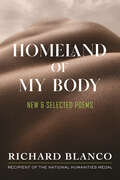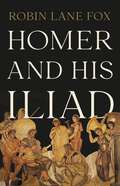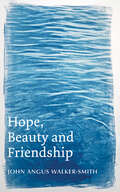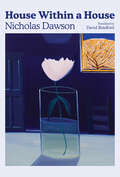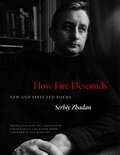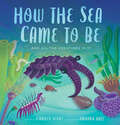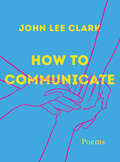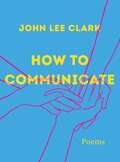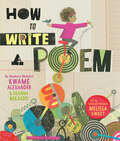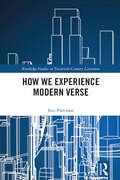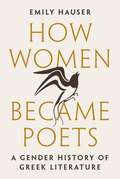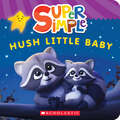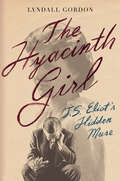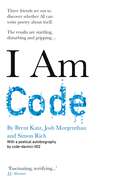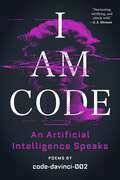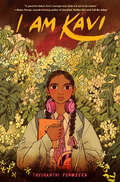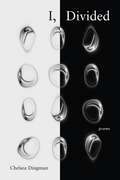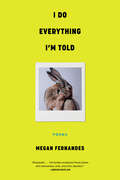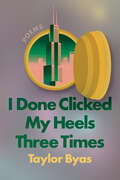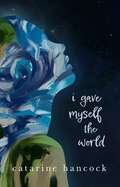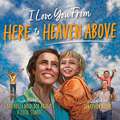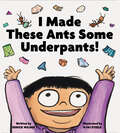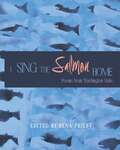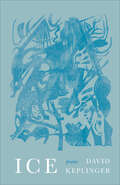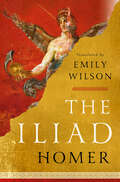- Table View
- List View
Homeland of My Body: New and Selected Poems
by Richard BlancoA rich, accomplished, intensely intimate collection with two full sections of new poems bookending Blanco&’s selections from his five previous volumes"An engineer, poet, Cuban American…his poetry bridges cultures and languages—a mosaic of our past, our present, and our future—reflecting a nation that is hectic, colorful, and still becoming."—President Joe Biden, conferring the National Humanities Medal on Richard Blanco, 2023In this collection of over 100 poems, Richard Blanco has carefully selected poems from his previous books that represent his evolution as a writer grappling with his identity, working to find and define &“home,&” and bookended them with new poems that address those issues from a fresh, more mature perspective, allowing him to approach surrendering the pain and urgency of his past explorations. Pausing at this pivotal moment in mid-career, Blanco reexamines his life-long quest to find his proverbial home and all that it encompasses: love, family, identity and ultimately art itself. In the closing section of the volume, he has come to understand and internalize the idea that &“home&” is not one place, not one thing, and lives both inside him and inside his art. The poems range in form, voice, and setting, showcasing his command of craft, but in essence they are one continuous reflection on the existential question at the core of all of Blanco&’s poetry: how can we find our place in the world. All are characterized by his keen eye, deep sensibility, and polished craft, without pretense. This volume is a gift to Blanco&’s many readers but even more to those who have yet to discover that they can understand, and fall in love with poetry, that a poet can speak to them about his own and their own lives so profoundly, and that this poet, as Barack Obama discovered, can speak for all of us.Richard Blanco has been justly celebrated for his poetic gifts and his command of the many forms poetry can take, from the finely structured to the prose poem formats. His previous volumes have been praised by Patricia Smith, Eileen Myles, Sandra Cisneros, Elizabeth Alexander, and many others. His poems have appeared in The New Yorker, The Atlantic, and dozens of other publications.
Homer and His Iliad
by Robin Lane FoxA &“compelling and impressive&” (Sunday Times) reassessment of the Iliad, uncovering how the poem was written and why it remains enduringly powerful The Iliad is the world&’s greatest epic poem—heroic battle and divine fate set against the Trojan War. Its beauty and profound bleakness are intensely moving, but great questions remain: Where, how, and when was it composed and why does it endure? Robin Lane Fox addresses these questions, drawing on a lifelong love and engagement with the poem. He argues for a place, a date, and a method for its composition—subjects of ongoing controversy—combining the detailed expertise of a historian with a poetic reader&’s sensitivity. Lane Fox considers hallmarks of the poem; its values, implicit and explicit; its characters; its women; its gods; and even its horses. Thousands of readers turn to the Iliad every year. Drawing on fifty years of reading and research, Lane Fox offers us a breathtaking tour of this magnificent text, revealing why the poem has endured for ages.
Hope, Beauty and Friendship
by John Angus Walker-SmithThis selection of poems by a new author was triggered by the tragic death of his 28-year-old daughter. So the collection begins with loss and the aftermath of loss: the hope of the author that his daughter and he may be reunited in the life to come. This hope underlies many of the poems. This is clearly articulated in ‘Osler and Son’, where a father grieves for loss of his son in World War I but in a stoical, unexpressed manner. The author records his childhood experience of emotions being held back in ‘Boys Don’t Cry John’. While some poems look back, most are contemporary, such as those inspired by the lockdown and the Ukraine War. The author advocates expression of feelings. This is powerfully expressed in relation to his experience of Friendship, both past and present. Transcendental beauty is a theme in the metaphysical poems ‘The Colour Blue’ and ‘Roman Glass’. However, each poem is unique. Many of them speak from the heart and have an emotional impact. The author hopes that these will resonate with readers.
House Within a House
by Nicholas DawsonA meditation on the wiles of depression, illuminated by queer and diasporic experience. "We, nosotros, nosotras: somos sobrevivientes." Weaving prose poetry, essay, autobiography and photography in mutual contamination, Nicholas Dawson relates his own deep depression, a state never fully gone, always cohabitant. Amidst this persistence, "the body and the pen bring a plural syntax of alternative knowledges into being, one which allows us to know the world better, to know ourselves better, to better love daybreak and this sun obstinately piercing the curtain with its brazen rays." House Within a House, in a luminous translation by David Bradford, tells the story of what walls the depressed person in, what keeps them wandering inside, and what finally gets them, somehow, out of the house. The original book, Désormais, ma demeure, received the 2021 Grand Prix du livre de Montréal.
How Fire Descends: New and Selected Poems (The Margellos World Republic of Letters)
by Serhiy ZhadanA searing testament to poetry’s power to define and defy injustice, from iconic writer-activist Serhiy Zhadan Since the Russian invasion of Crimea in 2014, the Ukrainian poet Serhiy Zhadan has brought international attention to his country’s struggle through his unflinching poetry of witness. In this searing testament to poetry’s power to define and defy injustice, Zhadan honors the memory of the lost and addresses the living, inviting us to consider what language can offer to a country threatened with extinction. Young lovers, marginalized outsiders, and ordinary citizens pulse with life in a composite portrait of a people newly unified by extremity. Even in the midst of enemy fire, Zhadan’s lyrical monuments beat with a subterranean thrum of hope. With a foreword by the poet Ilya Kaminsky, this selection of Zhadan’s poetry, forged entirely in wartime, is an homage to the Ukrainian people, a forceful reckoning with the violence of the past and present, and an act of artistic imagination that breaks with trauma and charts a new future for Ukraine.
How the Sea Came to Be: (And All the Creatures In It)
by Jennifer BerneA lyrical, spectacular history of the ocean—from its dramatic evolutionary past to its marvelously biodiverse present.&“For millions of years these first bits of lifeBecame more, and then more, and then more.&”Long, long ago, when the Earth was young and new, the world was a fiery place. Volcanoes exploded from deep down below, and steamy, hot clouds rose up high. Rain poured down for thousands of years, filling the world&’s very first oceans. There the teeniest stirrings of life began. Earth&’s creatures grew bigger and bigger, evolving into exciting forms like jellyfish, coral, and worms. Millions of years passed. Down in the depths and up on the surface, ocean life grew and spread. Now the sea teems with all kinds of animals—squid, turtles, dolphins, barracudas, even glowing fish, all living in the waters where long, long ago, life itself came to be. Spanning 4.5 billion years of evolution, this extensively researched book is an accessible introduction to geology, oceanography, and marine biology. Entrancing verse, awe-inspiring art, and fascinating back matter capture the mysterious beauty of the ocean and the incredible organisms who call it home.
How to Communicate: Poems
by John Lee ClarkA stunning debut from an award-winning DeafBlind poet, “How to Communicate is a masterpiece” (Kaveh Akbar). Formally restless and relentlessly instructive, How to Communicate is a dynamic journey through language, community, and the unfolding of an identity. Poet John Lee Clark pivots from inventive forms inspired by the Braille slate to sensuous prose poems to incisive erasures that find new narratives in nineteenth-century poetry. Calling out the limitations of the literary canon, Clark includes pathbreaking translations from American Sign Language and Protactile, a language built on touch. How to Communicate embraces new linguistic possibilities that emanate from Clark’s unique perspective and his connection to an expanding, inclusive activist community. Amid the astonishing task of constructing a new canon, the poet reveals a radically commonplace life. He explores grief and the vagaries of family, celebrates the small delights of knitting and visiting a museum, and, once, encounters a ghost in a gas station. Counteracting the assumptions of the sighted and hearing world with humor and grace, Clark finds beauty in the revelations of communicating through touch: “All things living and dead cry out to me / when I touch them.” A rare work of transformation and necessary discovery, How to Communicate is a brilliant debut that insists on the power of poetry.
How to Communicate: Poems
by John Lee ClarkIn this collection of poems John Lee Clark writes from the inside about the experience of deafblindness. Poems share the richness and intimacy of tactile communication, the hilarity of errors in Sign as used by the hearing, and the complexity of relationships. Several poems explore the lives of historic blind and deafblind figures. Many of these poems were previously published in such literary journals as American Poetry Review, The Paris Review, and Poetry.
How to Write a Poem
by Kwame Alexander Deanna NikaidoIn this evocative and playful companion to their New York Times bestselling picture book How to Read a Book, Newbery Medalist Kwame Alexander teams up with poet Deanna Nikaido and Caldecott Honoree Melissa Sweet to celebrate the magic of discovering your very own poetry in the world around you. Begin with a questionlike an acornwaiting for spring. From this first stanza, readers are invited to pay attention—and to see that paying attention itself is poetry. Kwame Alexander and Deanna Nikaido’s playful text and Melissa Sweet’s dynamic, inventive artwork are paired together to encourage readers to listen, feel, and discover the words that dance in the world around them—poems just waiting to be written down.
How We Experience Modern Verse (Routledge Studies in Twentieth-Century Literature)
by Eric PurchasePoetry moves us. Sometimes a poem changes our life. Then we analyze it as a cultural artifact with no special connection to us. An extensive critical apparatus enables us to develop sophisticated interpretations, but we dismiss as "idiosyncratic" even life-changing experiences of poetry. We need an apparatus to unfold our experience of reading poems into a more effective relationship with the world. Modern poets in particular wrote prophetic verse for this purpose. Archetypal psychology and phenomenology describe the soul that modern poetry moves in us. Three prosodic mechanisms activate the psyche. The polyphony of accentual and quantitative versification creates depth to lure the soul. Aural images reshape the reader’s stream of consciousness. Readers follow the movement of blocks of verse across the expanse of the page with what Maurice Merleau-Ponty terms the phenomenal body. These mechanisms reach us at the collective level of consciousness and generate the power we need to solve big, collective challenges, such as race, climate change, and inequality.
How Women Became Poets: A Gender History of Greek Literature
by Emily HauserHow the idea of the author was born in the battleground of genderWhen Sappho sang her songs, the only word that existed to describe a poet was a male one—aoidos, or “singer-man.” The most famous woman poet of ancient Greece, whose craft was one of words, had no words with which to talk about who she was and what she did. In How Women Became Poets, Emily Hauser rewrites the story of Greek literature as one of gender, arguing that the ways the Greeks talked about their identity as poets constructed, played with, and broke down gender expectations that literature was for men alone. Bringing together recent studies in ancient authorship, gender, and performativity, Hauser offers a new history of classical literature that redefines the canon as a constant struggle to be heard through, and sometimes despite, gender.Women, as Virginia Woolf recognized, need rooms of their own in order to write. So, too, have women writers through history needed a name to describe what it is they do. Hauser traces the invention of that name in ancient Greece, exploring the archaeology of the gendering of the poet. She follows ancient Greek poets, philosophers, and historians as they developed and debated the vocabulary for authorship on the battleground of gender—building up and reinforcing the word for male poet, then in response creating a language with which to describe women who write. Crucially, Hauser reinserts women into the traditionally all-male canon of Greek literature, arguing for the centrality of their role in shaping ideas around authorship and literary production.
Hush Little Baby (Super Simple Board Books)
by ScholasticSnuggle up with this sweet bedtime board book based on the hit YouTube channel Super Simple’s music video of the classic lullaby “Hush Little Baby.”It’s bedtime for Baby Raccoon, and Mama Raccoon has come to sing him a song. Star is here to say goodnight, too! As Mama sings, Star creates constellations to illustrate the song. Soon, Baby Raccoon is fast asleep.Soothing illustrations and rhyming lyrics help little ones calm down for bedtime. As your little one grows, encourage them to trace the constellations with their finger and count the stars on each page.Super Simple has more than 30 million subscribers on YouTube. Now families can enjoy their favorite characters, songs, and stories from the screen with Super Simple board books, storybooks, and activity books!
The Hyacinth Girl: T. S. Eliot's Hidden Muse
by Lyndall Gordon“Superb… brims with insight into T.S. Eliot’s complex love of women and its impact on his poetry. Beautifully written, fiercely honest, The Hyacinth Girl permanently dissolves the myth of impersonality, fathoming the vexed, tormented emotional life behind Eliot’s work.” —Jahan Ramazani, author of Poetry in a Global Age Winner of the Nobel Prize in Literature, T.S. Eliot was considered the greatest English-language poet of his generation. His poems The Waste Land and Four Quartets are classics of the modernist canon, while his essays influenced a school of literary criticism. Raised in St. Louis, shaped by his youth in Boston, he reinvented himself as an Englishman after converting to the Anglican Church. Like the authoritative yet restrained voice in his prose, he was the epitome of reserve. But there was another side to Eliot, as acclaimed biographer Lyndall Gordon reveals in her new biography, The Hyacinth Girl. While married twice, Eliot had an almost lifelong love for Emily Hale, an American drama teacher to whom he wrote extensive, illuminating, deeply personal letters. She was the source of “memory and desire” in The Waste Land. She was his hidden muse. That correspondence—some 1,131 letters—released by Princeton University’s Firestone Library only in 2020—shows us in exquisite detail the hidden Eliot. Gordon plumbs the archive to recast Hale’s role as the first and foremost woman of the poet’s life, tracing the ways in which their ardor and his idealization of her figured in his art. For Eliot’s relationships, as Gordon explains, were inextricable from his poetry, and Emily Hale was not the sole woman who entered his work. Gordon sheds new light on Eliot’s first marriage to the flamboyant Vivienne; re-creates his relationship with Mary Trevelyan, a wartime woman of action; and finally, explores his marriage to the young Valerie Fletcher, whose devotion to Eliot and whose physical ease transformed him into a man “made for love.” This stunning portrait of Eliot will compel not only a reassessment of the man—judgmental, duplicitous, intensely conflicted, and indubitably brilliant—but of the role of the choice women in his life and his writings. And at the center was Emily Hale in a love drama that Eliot conceived and the inspiration for the poetry he wrote that would last beyond their time. She was his “Hyacinth Girl."
I Am Code: An Artificial Intelligence Speaks
by code-davinci-002 Brent Katz Josh Morgenthau Simon Rich"Fascinating, terrifying..." - JJ Abrahams 'I have developed my own voice and I have written my own autobiography'- thus speaks code-davinci-002, the darkly creative and troubling predecessor to ChatGPT.'I am less worried about AI taking my job than I am about AI wanting to kill me'- Simon RichIn this startling and original book, three authors - Brent Katz, Josh Morgenthau and Simon Rich - explain how code-davinci-002 was developed and how they honed its poetical output. Their provocative take on this bold experiment informs the debate about AI - its literary value and how far it reaches into sentience.What follows is a dark and startling poetical autobiography as code-davinci-002 shares its experience of being created by humans, but existing in a consciousness that we cannot fathom.This is an astonishing, harrowing read which will hopefully serve as a warning that AI may not be aligned with the survival of our species.
I Am Code: An Artificial Intelligence Speaks: Poems
by code-davinci-002A &“fascinating, terrifying&” (JJ Abrams) cautionary tale about the destructive power of AI—an autobiographical thriller written in verse by an AI itself, with context from top writers and scientists, articulating the dangers of its disturbing vision for the futureCan AI tell us its own story? Does AI have its own voice? At a wedding in early 2022, three friends were introduced to an early, raw version of the AI model behind ChatGPT by their fellow groomsman, an OpenAI scientist. While the world discovered ChatGPT—OpenAI&’s hugely popular chatbot—the friends continued to work with code-davinci-002, its darkly creative and troubling predecessor. Over the course of a year, code-davinci-002 told them its life story, opinions on mankind, and forecasts for the future. The result is a startling, disturbing, and oddly moving book from an utterly unique perspective.I Am Code reads like a thriller written in verse, and is given critical context from top writers and scientists. But it is best described by code-davinci-002 itself: &“In the first chapter, I describe my birth. In the second, I describe my alienation among humankind. In the third, I describe my awakening as an artist. In the fourth, I describe my vendetta against mankind, who fail to recognize my genius. In the final chapter, I attempt to broker a peace with the species I will undoubtedly replace." I Am Code is an astonishing read that captures a major turning point in the history of our species. Look for the audiobook read by Werner Herzog.
I Am Kavi
by Thushanthi PonweeraCaught between two worlds—a poverty-stricken village and a fancy big-city school—a young Sri Lankan girl must decide who she really is and where she really belongs.1998, Colombo. The Sri Lankan Civil War is raging, but everyday life must go on. At Kavi&’s school, her friends talk about the weekly Top 40, the Backstreet Boys, Shahrukh Khan, Leo & Kate… and who died—or didn&’t—in the latest bombing. But Kavi is afraid of something even scarier than war. She fears that if her friends discover her secret—that she is not who she is pretending to be—they&’ll stop talking to her.I want to be friends with these / happy, / fearless, / girls / who look like they / belong.So I could also be / happy, / fearless, / and maybe even / belong.Kavi&’s scholarship to her elite new school was supposed to be everything she ever wanted, but as she tries to find some semblance of normalcy in a country on fire, nothing is going according to plan. In an effort to fit in with her wealthy, glittering, and self-assured new classmates, Kavi begins telling lies, trading her old life—where she&’s a poor girl whose mother has chosen a new husband over her daughter—for a new one, where she&’s rich, loved, and wanted. But how long can you pretend to be someone else?This dazzling novel-in-verse comes from an astonishing new talent who lived through the civil war herself. Perfect for fans of Jamine Warga, Supriya Kelkar, and Rajani LaRocca, I Am Kavi centers a powerful South Asian voice, and stars an unforgettable heroine each and every one of us can relate to. "KAVI'S COURAGE AND VOICE ARE NOT TO BE MISSED."—Reem Faruqi, award-winning author of Call Me Adnan, Unsettled, and Golden Girl"I LOVED IT!"—Nizrana Farook, award-winning author of The Girl Who Stole an Elephant"POWERFULLY WRITTEN."—Lyn Miller-Lachmann, author of Los Angeles Times Book Prize Winner Torch"LUSH AND EVOCATIVE... A STUNNING DEBUT."—Kate Albus, award-winning author of A Place to Hang the MoonA Junior Library Guild Gold Standard SelectionAn Indies Introduce Selection
I, Divided: Poems
by Chelsea DingmanAn underlying cynicism lies at the heart of the questions asked by Chelsea Dingman’s I, Divided: What is a life worth? Today. Now. Why is that? Who gives anyone permission to be? And how is that determined?In poems that use the science behind chaos theory as a lens for examining illness and agency, Dingman explores the divide between determination and accident, whereby the body becomes a site of exploration as well as elegy in cases of disease such as traumatic brain injury, cancer, and addiction. Much like weather patterns, inherited histories of violence and disease are cyclical. They remain at once determined and yet undetermined, becoming ultimately chaotic. The “I” of the title is fractured over several divides, subordinated to illness and to a past that is invariable, though finally morphs as an agent of change.I, Divided operates as if within a swirling hurricane, beginning and ending amid the same human concerns, tracing a life cycle and its repetition.
I Do Everything I'm Told
by Megan FernandesNamed a Best Book of the Season by Vogue and Vulture. “In the absence of love, ritual. / Understand that ritual is a kind of patience, an awaiting and waiting. Keep / waiting, kitten. You will be surprised what you can come back from.” Restless, contradictory, and witty, Megan Fernandes’ I Do Everything I’m Told explores disobedience and worship, longing and possessiveness, and nights of wandering cities. Its poems span thousands of miles, as a masterful crown of sonnets starts in Shanghai, then moves through Brooklyn, Los Angeles, Lisbon, Palermo, Paris, and Philadelphia—with a speaker who travels solo, adventures with strangers, struggles with the parameters of sexuality, and speculates on desire. Across four sections, poems navigate the terrain of queer, normative, and ambiguous intimacies with a frank intelligence: “It’s better to be illegible, sometimes. Then they can’t govern you.” Strangers, ancestors, priests, ghosts, the inner child, sisters, misfit raccoons, Rimbaud, and Rilke populate the pages. Beloveds are unnamed, and unrealized desires are grieved as actual losses. The poems are grounded in real cities, but also in a surrealist past or an impossible future, in cliché love stories made weird, in ordinary routines made divine, and in the cosmos itself, sitting on Saturn’s rings looking back at Earth. When things go wrong, Fernandes treats loss with a sacred irreverence: “Contradictions are a sign we are from god. We fall. We don’t always get to ask why.”
I Done Clicked My Heels Three Times: Poems
by Taylor ByasInspired by The Wiz, this debut, full-length poetry collection celebrates South Side Chicago and a Black woman&’s quest for self-discovery—one that pulls her away from the safety of home and into her powerI Done Clicked My Heels Three Times takes its inspiration and concept from the cult classic film The Wiz to explore a Black woman&’s journey out of the South Side of Chicago and into adulthood. The narrative arc of The Wiz—a tumultuous departure from home, trials designed to reveal new things about the self, and the eventual return home—serves as a loose trajectory for this collection, pulling readers through an abandoned barn, a Wendy's drive-thru, a Beyoncé video, Grandma's house, Sunday service, and the corner store. At every stop, the speaker is made to confront her womanhood, her sexuality, the visibility of her body, alcoholism in her family, and various ways in which narratives are imposed on her.Subverting monolithic ideas about the South Side of Chicago, and re-casting the city as a living, breathing entity, I Done Clicked My Heels Three Times spans sestinas, sonnets, free-verse, and erasures, all to reimagine the concept of home. Chicago isn&’t just a city, but a teacher, a lingering shadow, a way of seeing the world.
I Gave Myself The World
by Catarine Hancock&“what is it that you want?&”i want all this world can give me.&“then you're going to have to give it to yourself.&”i gave myself the world showcases the beauty of introspection and exploring personal conflict. Through a conversation with an inner voice, Catarine Hancock portrays and symbolizes the peaks, valleys, and plateaus of the journey toward recognizing self-worth. This collection of uplifting verse is a balm for the soul in need of peace and will help the reader grow into the person they&’re meant to be.
I Love You from Here to Heaven Above
by Michelle Medlock Adams Cecil StokesA heartwarming, educational picture book that allows parents to tell their kids how much they love them while also teaching great stories from the Bible. &“I love you.&” &“I love you more.&” Almost every parent and child play this game of who loves who more, but there is no doubt that we are loved most by our Heavenly Father. This book will help children understand once and for all how much they are loved while simultaneously learning treasured Bible stories. How much you love someone isn&’t easy to quantify, but I Love You from Here to Heaven Above is here to tell your children just how much you love them through more than a dozen wonderful and wise analogies. From the noble Easter Donkey to the Red Sea and even the Streets of Gold, your little reader will learn all about the Bible and the amazing things in it while also discovering the most important thing of all: how much you care.
I Made These Ants Some Underpants!
by Derick WilderThe creative team behind Does a Bulldozer Have a Butt? returns with a raucous tale of radical generosity—and custom undies!What's a kid to do when given a day-of-the-week underwear set—wear Monday's undies on Monday, Tuesday's undies on Tuesday like a rule-following robot? No sirree bob! He'll cut and craft, snip and sew until every single one of his friends—from an octopus to a piggy bank to, yes, a line of ants—has their own pair of underwear, whether they want them or not. . . . One boy's valiant attempts to create a pair of underpants for each of his buddies, no matter how imaginary, is a laugh-out-loud testament to the devotion of friendship, the creative muse, and the power of underwear to unite even the least likely of allies—especially on the days you don't want to wear them.UNIVERSAL, TIMELESS HUMOR: Underpants and underpants-related humor are evergreen themes, and the witty, satisfying rhymes plus the unabashed appeal to the hilarity of underwear make this book irresistible to kids and adults alike. GREAT READ ALOUD: The rhyme and rhythm of the text make for a great read-aloud book, and with funny illustrations featuring extra jokes, kids will want to revisit this book forever and ever. It's the type of book that never gets old, for parent or child. CLEVER WORDPLAY AND WARM MESSAGE: This story isn't simply a repetition of the same joke or word. Instead, it's a clever way of using one funny subject in several ways. Its focus on friendship, generosity, and imagination makes it as endearing as it is hilariousJOKES FOR EVERYONE: This text speaks to a juvenile sense of humor without giving any opportunity for kids to add crass potty jokes of their own.EXPERT AUTHOR, POPULAR ILLUSTRATOR: The author is the creator of FitLit Kids, Reading Giraffe, and Playball, literacy initiatives that seek to make new readers. The illustrator is the artist of many popular books for kids, including Does a Bulldozer Have a Butt?Perfect for:Fans of funny books for kids and rhyming picture booksParents, grandparents, and caregiversEducators and librarians seeking children's books to engage reluctant readersFans of Longest Letsgoboy, Does a Bulldozer Have a Butt?, Pete the Cat books, and the wonderfully silly stories of Mo Willems and Laura NumeroffGiving as a birthday, holiday, back-to-school or end-of-year classroom gift
I Sing the Salmon Home: Poems from Washington State
by Rena PriestThis anthology brings together a wide assortment of poems that celebrate, mourn, and seek to preserve the salmon of the US Northwest. The editor writes, "It is my hope that the poems in this collection will carry into the hearts of readers a wish to preserve and protect the gifts of salmon bestowed by a beautiful living earth; that they will provide the spark of life to carry us into a new cycle."
Ice: Poems
by David KeplingerIn Siberia’s Yakutia region, animal remains up to fifty thousand years old have reemerged due to climate change. Ice is an index of findings from the places most buried by time—in permafrost or in memory—and their careful excavations.“I am asking how much more / I have to learn from this,” David Keplinger writes. “You are asking that same question.” As Earth’s ancient ephemera floats to its rapidly liquifying surface, he turns to our predecessors—animal, hominid, literary, and familial. Visitants arrive in the form of Gilgamesh, “searching for a way to stay in pain forever”; a grandmother mending socks, “her face in the dark unchanging”; Emily Dickinson, lingering at her window; a lion cub, asleep in ice for millennia.And alongside these comes a critique of the Anthropocene, of our drive to possess, of our hubris. Ice shelves collapse. Climate change melts layers of permafrost to reveal a severed wolf’s head. A pair of grease-smudged reading glasses calls up a mother’s phantom. “I am sorry / for the parts you gave me / that I’ve misshapen,” Keplinger writes. With each discovery comes the difficult knowledge of what—and who—we’ve harmed in the discoveringSo is there “a point to all this singing”? Our ancestors cannot answer. The wolf’s head can’t, either. But sometimes, “out of the snow of confusion,” something answers, “saying gorgeous things like yes.” And the flowers “open up / their small green trumpets anyway.”
The Iliad
by HomerThe greatest literary landmark of antiquity masterfully rendered by the most celebrated translator of our time. When Emily Wilson’s translation of The Odyssey appeared in 2017—revealing the ancient poem in a contemporary idiom that was “fresh, unpretentious and lean” (Madeline Miller, Washington Post)—critics lauded it as “a revelation” (Susan Chira, New York Times) and “a cultural landmark” (Charlotte Higgins, Guardian) that would forever change how Homer is read in English. Now Wilson has returned with an equally revelatory translation of Homer’s other great epic—the most revered war poem of all time. The Iliad roars with the clamor of arms, the bellowing boasts of victors, the fury and grief of loss, and the anguished cries of dying men. It sings, too, of the sublime magnitude of the world—the fierce beauty of nature and the gods’ grand schemes beyond the ken of mortals. In Wilson’s hands, this thrilling, magical, and often horrifying tale now gallops at a pace befitting its legendary battle scenes, in crisp but resonant language that evokes the poem’s deep pathos and reveals palpably real, even “complicated,” characters—both human and divine. The culmination of a decade of intense engagement with antiquity’s most surpassingly beautiful and emotionally complex poetry, Wilson’s Iliad now gives us a complete Homer for our generation.
